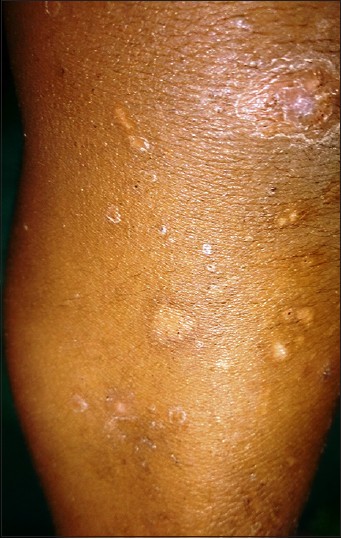Translate this page into:
Insect bite reaction and HIV infection
Correspondence Address:
S Pradeep Nair
Department of Dermatology and Venereology, Government Medical College, Trivandrum - 695 011, Kerala
India
| How to cite this article: Nair S P. Insect bite reaction and HIV infection. Indian J Dermatol Venereol Leprol 2015;81:95 |
Sir,
Exaggerated insect bite reaction (IBR), also known as papular urticaria, is one of the most common cutaneous manifestations seen in human immunodeficiency virus (HIV) infection. [1] Insect bite reaction is very common in HIV patients in tropical countries because of the high mosquito population. However, it is not solely due to mosquito bites, as the bites of ticks and mites of household pets can also cause a similar clinical picture. In the absence of other causes of immunosuppression like malignancies and immunosuppressive therapy, insect bite reaction is a strong marker for HIV infection. This highly-distressing condition belongs to the group of the so-called non-infectious pruritic papular eruptions of HIV. However, all pruritic papular eruptions of HIV are not insect bite reactions. It usually presents with severely pruritic papules, pustules and papulo-vesicular lesions on the exposed parts of the body, usually at the site of mosquito bites, mainly the extensor aspect of upper limbs, lower limbs and the face [Figure - 1]. Due to the severe pruritus, necrotic and excoriated papules with secondary infection and eczematization may occur [Figure - 2]. However, since many conditions in HIV infection can cause severe pruritic papules, the following conditions have to be eliminated before making a diagnosis of insect bite reaction [2] : scabies, pityriosporum folliculitis, demodex folliculitis, bacterial and viral folliculitis, eosinophilic pustular folliculitis and drug reactions, all of which can present with severely pruritic papules, but not necessarily on the exposed parts of the body. Eosinophlic pustular folliculitis, a close mimic of insect bite reaction, presents with papules and pustules on the head, neck and upper chest with distinct histopathological features.
 |
| Figure 1: Papules of insect bite reaction on extensor aspect of forearms |
 |
| Figure 2: Insect bite reaction with secondary infection and eczematization |
A prospective observational study in our department of 131 consecutive HIV patients demonstrated insect bite reaction as the most common cutaneous manifestation, seen in 21 (16.0%) cases. The mean CD4 count in patients with insect bite reaction was 223 cells/mm 3 , indicating gross immunosuppression. The mean CD4 counts in males was 198 cells/mm 3 , technically AIDS, while the mean CD4 count in females was 241 cells/mm 3 . The prevalence of this condition in various studies range from 9% to 36.6%, with CD4 counts ranging from 100 to 200 cells/mm 3 , all indicating advanced immunosuppression. [3]
Exaggerated insect bite reaction is attributed to the immune dysregulation and hypereosinophilia seen in HIV patients. Some studies also show it to be an altered host reaction to salivary antigens of the mosquito. [4] The predominant Th2 response seen in HIV patients is an important factor in the pathogenesis of this condition. Th2 lymphocytes produce IL-4 and IL-5 which in turn promote IgE production and eosinophil differentiation. IgE mediated degranulation of mast cells and chemokines like eosinophilic chemotactic factor of anaphylaxis and major basic proteins produced by the eosinophils, causes severe itching and consequently the clinical lesions of this condition. [4]
Histopathology of insect bite reaction may show spongiosis and blistering in the epidermis, while the dermis shows a characteristic perivascular infiltrate by neutrophils, eosinophils, mononuclear cells and plasma cells. In contrast, the histopathology of eosinophlic pustular folliculitis shows follicular spongiosis and a folliculo-centric dense inflammatory infiltrate of eosinophils and lymphocytes. [4]
Treatment of this condition is difficult and unsatisfactory. Topical steroids and antihistamines may give relief in some patients, while it may not work in other patients. Some patients have noted improvement with starting of anti-retroviral therapy, though the evidence for this is not strong. Phototherapy, thalidomide and pentoxifyllin are reported anecdotal therapies, but randomized controlled trials are lacking. Hence, the mainstay of therapy is prevention of mosquito bites. Protection against mosquitoes by using netting, synthetic pyrethroid mats, coils, liquidators and insect repellents like diethyl-m-toluamide (DEET) and dimethylphthalate (DMP), at night may help. [5]
| 1. |
Shobhana A, Guha SK, Neogi DK. Mucocutaneous manifestations of HIV infection. Indian J Dermatol Venereol Leprol 2004;70:82-6.
[Google Scholar]
|
| 2. |
Kumaraswamy N, Solomon S, Madhivanam P, Ravikumar B, Thyagarajan SP, Yesudian P. Dermatologic manifestations among human immunodeficiency virus patients in south India. Int J Dermatol 2000;39:192-5.
[Google Scholar]
|
| 3. |
Wiwanitkit V. Prevalence of dermatological disorders in Thai HIV-infected patients correlated with different CD4 lymphocyte count statuses: A note on 120 cases. Int J Dermatol 2004;43:265-8.
[Google Scholar]
|
| 4. |
Eisman S. Pruritic papular eruption in HIV. Dermatol Clin 2006;24:449-57, vi.
[Google Scholar]
|
| 5. |
Singh S, Mann BK. Insect bite reactions. Indian J Dermatol Venereol Leprol 2013;79:151-64.
[Google Scholar]
|
Fulltext Views
10,328
PDF downloads
3,075





